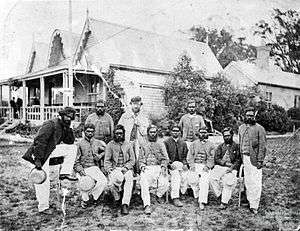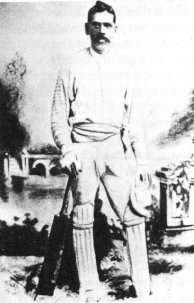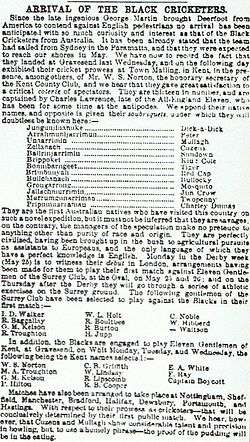Australian Aboriginal cricket team in England in 1868

In 1868, a cricket team composed of Australian Aborigines toured England between May and October of that year, thus becoming the first organised group of Australian sportspeople to travel overseas.[1] It would be another ten years before an Australian cricket team classed as representative would leave the country.
The concept of an Aboriginal cricket team can be traced to cattle stations in the Western District of Victoria, where, in the mid-1860s, European pastoralists introduced Aboriginal station hands to the sport. An Aboriginal XI was created with the assistance of Tom Wills—captain of the Victoria cricket team and founder of Australian rules football—who acted as the side's captain-coach in the lead-up to and during an 1866–67 tour of Victoria and New South Wales. Several members of this team joined what would become the Aboriginal XI that toured England under the captaincy of Englishman Charles Lawrence.
International sporting contact was rare in this era. Previously, only three cricket teams had travelled abroad, all English: to the United States and Canada in 1859, and to Australia in 1861–62 and 1863–64.
Background


In the Western District of Victoria from the early 1860s onwards, cricket matches took place on cattle stations between Aborigines and European settlers. Many Aborigines were employed as stockmen by local station owners. The Aborigines were admired for their athletic skills, and in early 1866, a series of matches were staged with the intention of selecting the strongest possible Aboriginal XI.
The resulting team was initially coached by local pastoralist William Hayman. Coaching duties were later turned over to Tom Wills, captain of the Victoria cricket team and founder of Australian rules football, who spoke to the team in an Aboriginal language he learnt as a child growing up in the Western District among the Djab Wurrung people. Wills' decision to join and help the team has been a source of intrigue, given that only five years earlier, he survived a massacre in Queensland in which his father and 18 other settlers were murdered by local Aborigines. "It was always a matter of wonder how Tom could be friendly with the blacks, considering that they murdered his father", recalled one sportswriter.[2]
On Boxing Day 1866, in front of over 10,000 spectators, Wills captained the team against the Melbourne Cricket Club at the Melbourne Cricket Ground. Bell's Life in Victoria reported: "Seldom has a match created more excitement in Melbourne than the one under notice, and never within our recollection has a match given rise to so much feeling on behalf of the spectators."[3] "The veteran Wills never captained an eleven who so thoroughly possessed the sympathies of the spectators," wrote a Melbourne correspondent for The Sydney Mail. "A dark skin suddenly became a passport to the good graces of Victorians."[4] Although they lost to the MCC, the Aborigines were commended for their performance, and showed marked improvement on a subsequent tour of country Victoria.
An entrepreneur, Captain Gurnett, persuaded the team to travel to Sydney to begin a planned tour of the colonies and England. However, after their arrival in Sydney in February 1867, Gurnett embezzled some of the funds raised to finance the enterprise, leaving the team stranded. The team, with the help of public donations, completed a tour of New South Wales before returning to Victoria in May. Four players succumbed to the effects of illness: Sugar and Watty died on tour, while Jellico and Paddy died shortly afterward.
Team members

The Aborigines returned to Victoria and a second attempt to organise a tour of England was initiated by new financial backers. The former Surrey professional cricketer Charles Lawrence, who coached the Albert Club in Sydney, became coach and manager of an Aboriginal team which included the surviving members of Wills' 1866–67 side, plus a handful of new players.
- Johnny Mullagh – traditional name: Unaarrimin
- Bullocky – traditional name: Bullchanach. A wicketkeeper, Bullocky was referred to as "at once the black Bannerman and Blackham of his team".[5]
- Sundown – traditional name: Ballrin
- Dick-a-Dick – traditional name: Jungunjinanuke
- Johnny Cuzens – traditional name: Zellanach
- King Cole – traditional name: Bripumyarrimin
- Red Cap – traditional name: Brimbunyah
- Twopenny – traditional name: Murrumgunarriman
- Charley Dumas – traditional name: Pripumuarraman
- Jimmy Mosquito – traditional name: Grougarrong, who "could walk upright under a bar and then jump it in a stander".[5]
- Tiger – traditional name: Boninbarngeet
- Peter – traditional name: Arrahmunijarrimun
- Jim Crow – traditional name: Jallachniurrimin
During June, King Cole died from tuberculosis and was buried in Tower Hamlets in London. Sundown and Jim Crow went home in August due to ill-health.[6]
The tour

The team arrived in London in May 1868[7] and were met with a degree of fascination - that being the period of the evolutionary controversies following publication of Charles Darwin's The Origin of Species in 1859. Reaction was mixed. The Times described the tourists as, "a travestie upon cricketing at Lord's", and, "the conquered natives of a convict colony." The Daily Telegraph said of Australia that, "nothing of interest comes from there except gold nuggets and black cricketers."
The first match was played at The Oval in London and attracted 20,000 spectators. Presumably many of these spectators attended out of curiosity to see members of a strange-looking race perform athletically rather than merely to savour a cricket contest. The Times reported:
"Their hair and beards are long and wiry, their skins vary in shades of blackness, and most of them have broadly expanded nostrils. Having been brought up in the bush to agricultural pursuits under European settlers, they are perfectly civilised and are quite familiar with the English language."
The Daily Telegraph wrote:
It is highly interesting and curious, to see mixed in a friendly game on the most historically Saxon part of our island, representatives of two races so far removed from each other as the modern Englishman and the Aboriginal Australian. Although several of them are native bushmen, and all are as black as night, these Indian fellows are to all intents and purposes, clothed and in their right minds.
Altogether, the Aborigines played 47 matches throughout England over a period of six months, winning 14, losing 14 and drawing 19; a good result that surprised many at the time. Their skills were said to range from individuals who were exceptional athletes down to two or three other team members who hardly contributed at all. The outstanding player was Johnny Mullagh. He scored 1,698 runs and took 245 wickets. An admired English fast bowler of the time, George Tarrant, bowled to Mullagh during a lunch interval and later said, "I have never bowled to a better batsman."
In addition to playing cricket, the Aborigines frequently put on an exhibition of boomerang and spear throwing at the conclusion of a match. Dick-a-Dick would also hold a narrow parrying shield and invite people throw cricket balls at him, which he warded off with the shield. The Aborigines were narrowly beaten in a cricket-ball-throwing competition by an emerging English all-rounder of star quality, 20-year-old W. G. Grace, who threw 118 yards.[8]
Aftermath
The team arrived back in Sydney in February 1869. They played a match against a military team the following month, then split up. Twopenny later moved to New South Wales and played for the colony against Victoria in 1870. Cuzens died of dysentery the following year. Mullagh was employed as a professional with the Melbourne Cricket Club and represented Victoria against the touring English team in 1879, when he top scored in the second innings.
The Central Board for Aborigines ruled in 1869 that it would be illegal to remove any Aborigine from the colony of Victoria without the approval of the government minister. This effectively curtailed the involvement of Aborigines in the game.
Legacy
In May 1988 a team of Aboriginal players, captained by John McGuire, toured England to mark the Australian Bicentenary, retracing the steps of the original tour.[9][10]
In 2002, various scholars, historians and cricketers, including Test great Ian Chappell, successfully campaigned to have the Aboriginal XI inducted into the Sport Australia Hall of Fame. Also that year, a documentary film about the team titled A Fine Body of Gentlemen was broadcast by the ABC.[11]
Footnotes
- ↑ "Aboriginal cricket: The first Australian tour of England, 1868". BBC News. 2013-07-09. Retrieved 2013-07-09.
- ↑ "Sporting Notes". The Maitland Mercury and Hunter River General. 15 March 1883. p. 6. Retrieved 19 May 2016.
- ↑ "M.C.C. vs. Ten Aboriginals with T. W. Wills". Bell's Life in Victoria and Sporting Chronicle (Melbourne). 29 December 1866. p. 2. Retrieved 25 January 2016.
- ↑ "Matters in Melbourne". The Sydney Mail (Sydney). 26 January 1867. p. 3. Retrieved 29 March 2016.
- 1 2 Old 'Un, "An Old Time Team of Darkies", Euroa Advertiser, 2 April 1897, p. 3.
- ↑ Ricketts, Olly (9 July 2013). "Aboriginal cricket: The first Australian tour of England, 1868". BBC News Magazine. BBC. Retrieved 9 July 2013.
- ↑ "The Home of CricketArchive". Cricketarchive.com. Retrieved 2014-04-06.
- ↑ "Aboriginies - The first Australian cricket team". Convictcreations.com. Retrieved 2014-04-06.
- ↑ "Bats Test". Glasgow Herald. 14 May 1988. Retrieved 25 June 2011.
- ↑ "Ashes of Dark Past". Brisbane Times. 21 June 2009. Retrieved 24 June 2011.
- ↑ "A Fine Body of Gentlemen". Film Illawarra. Archived from the original on 2005-04-04. Retrieved 2005-05-22.
See also
- Australian cricket team
- History of Test cricket (to 1883)
- List of matches of the Australian Indigenous cricket team
References
- Ashley Mallett (2002). Lords' Dreaming: Cricket on the Run - The 1868 Aboriginal Tour of England. ISBN 0-285-63640-5.
- Ashley Mallett, The Black Lords of Summer: The Story of the 1868 Aboriginal Tour of England and Beyond, University of Queensland, 2002. ISBN 0-7022-3262-9
- Bernard Whimpress (1999). Passport To Nowhere: Aborigines In Australian Cricket 1850-1939. Walla Walla Press, Sydney. ISBN 1-876718-06-4.
- John Mulvaney and Rex Harcourt (1988). Cricket Walkabout: The Australian Aborigines In England. Macmillan Australia. ISBN 0-333-43086-7.